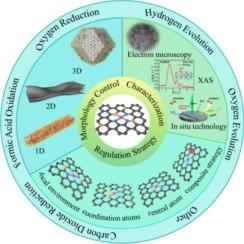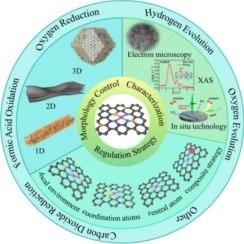用于电催化的 MOFs 单原子配位结构工程
IF 20.3
1区 化学
Q1 CHEMISTRY, INORGANIC & NUCLEAR
引用次数: 0
摘要
金属有机框架(MOFs)具有高比表面积、可调孔径和配体结构等特点,是合成单原子催化剂(SACs)的潜在前体,因此受到越来越多的关注。尽管人们在合成用于电催化的 MOFs 衍生 SACs 方面做出了巨大努力,但仍然缺乏制约其内在电催化性能的基本调节原理。本综述系统地总结了各种 MOFs 衍生 SAC 的最新进展。全面分析了中心金属原子、配位原子、局部环境、形态与其相应的电催化性能(包括活性、选择性和稳定性)之间的相关性。此外,还总结了先进的表征技术,以阐明 MOFs 衍生 SAC 的配体构型。最后,提出了 MOFs 衍生 SAC 的主要挑战和未来研究方向。本综述为设计具有良好配位结构的 MOFs 衍生 SAC 提供了全面的了解和最新的信息。本文章由计算机程序翻译,如有差异,请以英文原文为准。


Coordination structure engineering of single atoms derived from MOFs for Electrocatalysis
Metal-organic frameworks (MOFs) have attracted increasing attention as potential precursors for the synthesis of single atom catalysts (SACs) due to the high specific surface area, adjustable pore size, and ligand structure. Although significant efforts have been made to synthesize MOFs-derived SACs for electrocatalysis, it is still lack of fundamental regulation principles which governing the intrinsic electrocatalytic performance. In this review, the recent advancements in various MOFs-derived SACs are systematically summarized. The correlation between the central metal atoms, coordination atoms, local environment, morphology, and their corresponding electrocatalytic performance, including activity, selectivity and stability, is comprehensively analyzed. Furthermore, advanced characterization techniques are summarized to elucidate the ligand configuration of MOFs-derived SACs. Finally, the major challenges and future research directions for MOFs-derived SACs are proposed. This review provides a comprehensive understanding and updated information on the design of MOFs-derived SACs with well-confined coordination structures.
求助全文
通过发布文献求助,成功后即可免费获取论文全文。
去求助
来源期刊

Coordination Chemistry Reviews
化学-无机化学与核化学
CiteScore
34.30
自引率
5.30%
发文量
457
审稿时长
54 days
期刊介绍:
Coordination Chemistry Reviews offers rapid publication of review articles on current and significant topics in coordination chemistry, encompassing organometallic, supramolecular, theoretical, and bioinorganic chemistry. It also covers catalysis, materials chemistry, and metal-organic frameworks from a coordination chemistry perspective. Reviews summarize recent developments or discuss specific techniques, welcoming contributions from both established and emerging researchers.
The journal releases special issues on timely subjects, including those featuring contributions from specific regions or conferences. Occasional full-length book articles are also featured. Additionally, special volumes cover annual reviews of main group chemistry, transition metal group chemistry, and organometallic chemistry. These comprehensive reviews are vital resources for those engaged in coordination chemistry, further establishing Coordination Chemistry Reviews as a hub for insightful surveys in inorganic and physical inorganic chemistry.
 求助内容:
求助内容: 应助结果提醒方式:
应助结果提醒方式:


